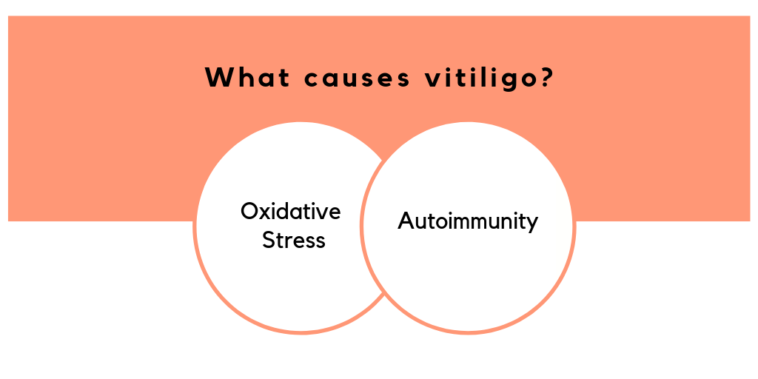Over the years, different studies have suggested different causes of vitiligo. However, the two most widely accepted hypothesis for the progressive loss of melanocytes are the autoimmune theory and oxidative stress. Recently, scientists have started to study if an interplay between oxidative stress and autoimmunity causes vitiligo in the first place.
As far as the autoimmunity theory is concerned, it is proposed that, in vitiligo, the immune system reacts against the body’s own cells and tissues, which destroys melanocytes. Vitiligo’ frequent association with other autoimmune disorders (mostly organ-specific) and positive response to immunosuppressive treatments in vitiligo fighters work in favor of the autoimmune hypothesis.
On the other hand, many studies conducted in the last decade seem to suggest that the cause of vitiligo is indeed oxidative stress – simply known as an overaccumulation of hydrogen peroxide, i.e. H2O2, in the skin. Low catalase is found in vitiligo, which triggers reactive oxygen species (ROS). This ROS accumulation can induce the loss of functionality of enzymes that plays a key role in melanogenesis. In addition to this, lipid peroxidation, DNA damage, increased production of proinflammatory, ultraviolet radiation, toxins, and stress can also induce ROS leading to oxidative stress.
But, there is the third angle to this story too. Many experts believe that oxidative stress and autoimmunity strictly interact in case of vitiligo to determine melanocyte loss in an individual. As per the scientific evidence and theories, it won’t be wrong to say that vitiligo has complex pathogenesis in which a pivotal role is played by autoimmunity and oxidative stress. Autoimmunity and oxidative stress interact and work together in creating a pathway that ultimately determines melanocyte loss.
The interplay between Oxidative Stress and Autoimmunity in Vitiligo
So far, the role of oxidative stress and autoimmunity in the pathogenesis of vitiligo was considered as mutually exclusive. However, recent findings suggested that these two mechanisms are involved in the depigmentation process synergically. In the case of vitiligo, it is possible that the immune system develops a chronic inflammatory milieu in which ROS accumulate and put forth a toxic effect on surrounding cells. As a result, structural or functional melanocytic proteins may get modified by acute and constant oxidative stress, perhaps becoming neoantigens that can trigger autoreactive reactions.
This is not it; a research paper published by the Department of Surgery and Translational Medicine, University of Florence, Italy also suggests that autoimmunity and oxidative stress coexist in vitiligo but might play different roles in initiating vitiligo.
What is the need of the hour?
While autoimmunity and autoimmunity are thought to be the initial pathogenic event in vitiligo, studies that establish a link between autoimmunity-oxidative stress and vitiligo have been mostly conducted with limited sample sizes and cross-sectional design. For that reason, more research studies need to be administered to establish the fact that Oxidative Stress and Autoimmunity interact in vitiligo.

